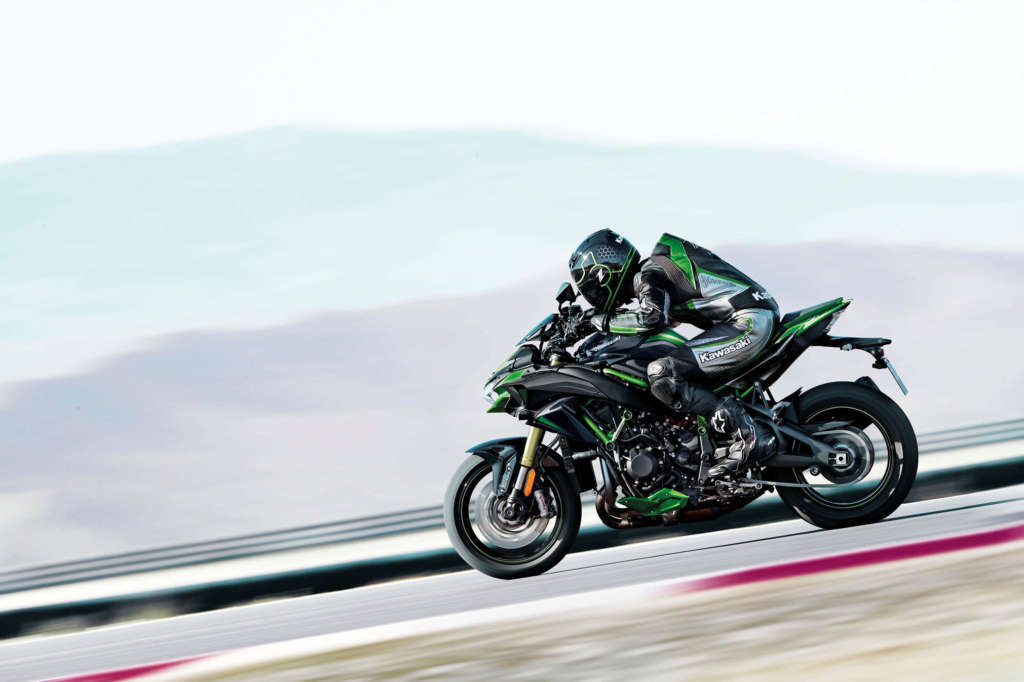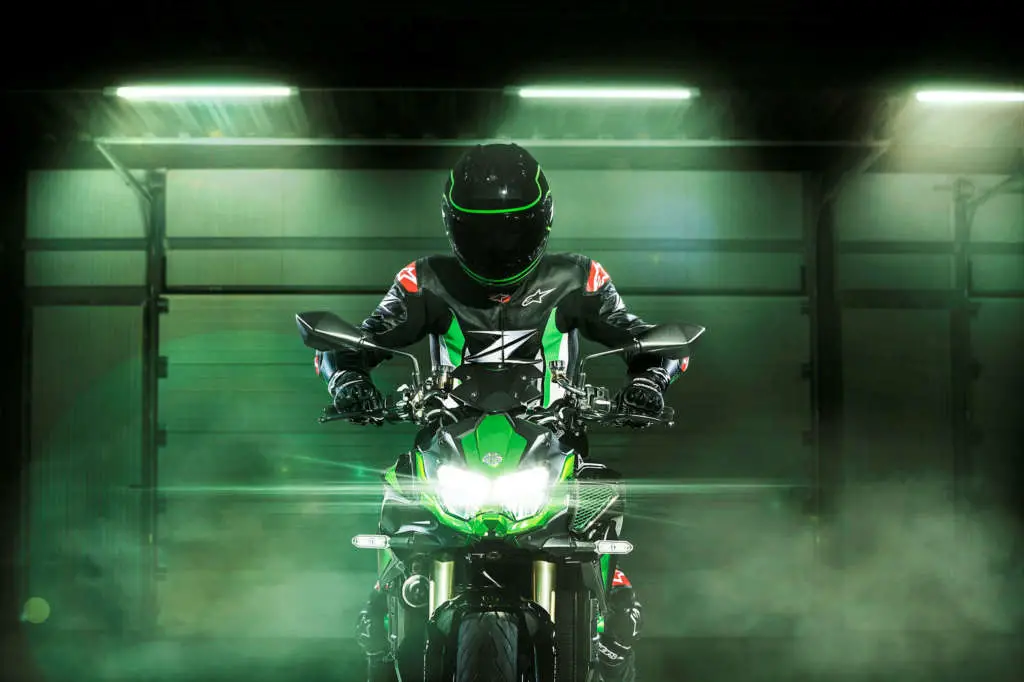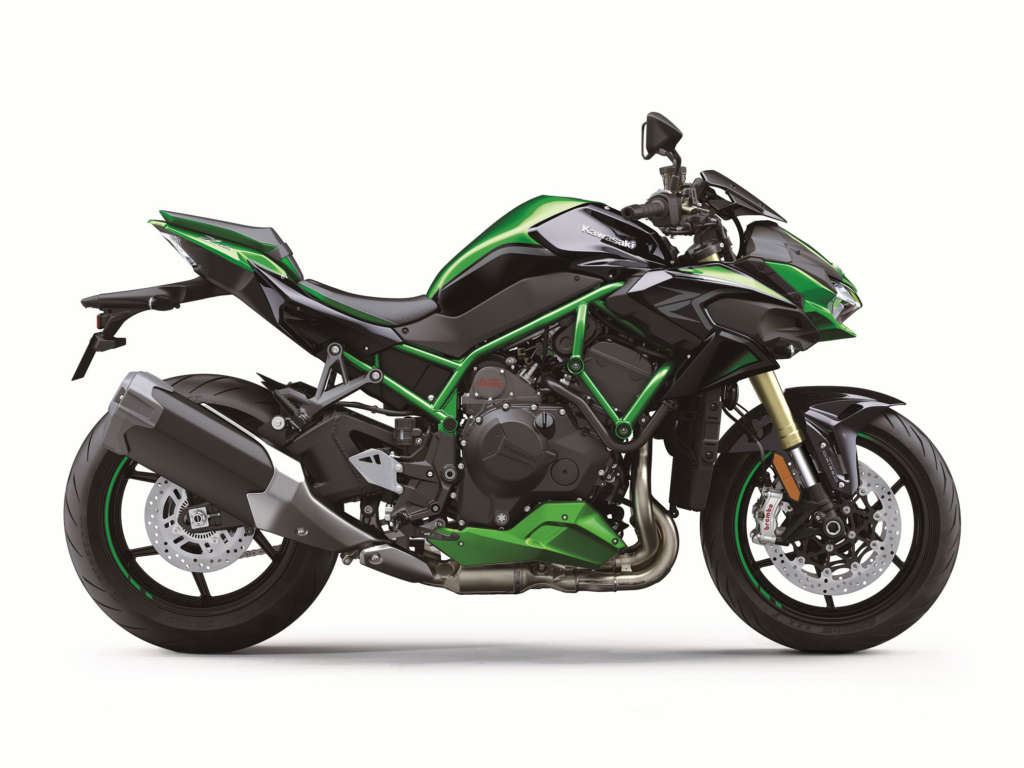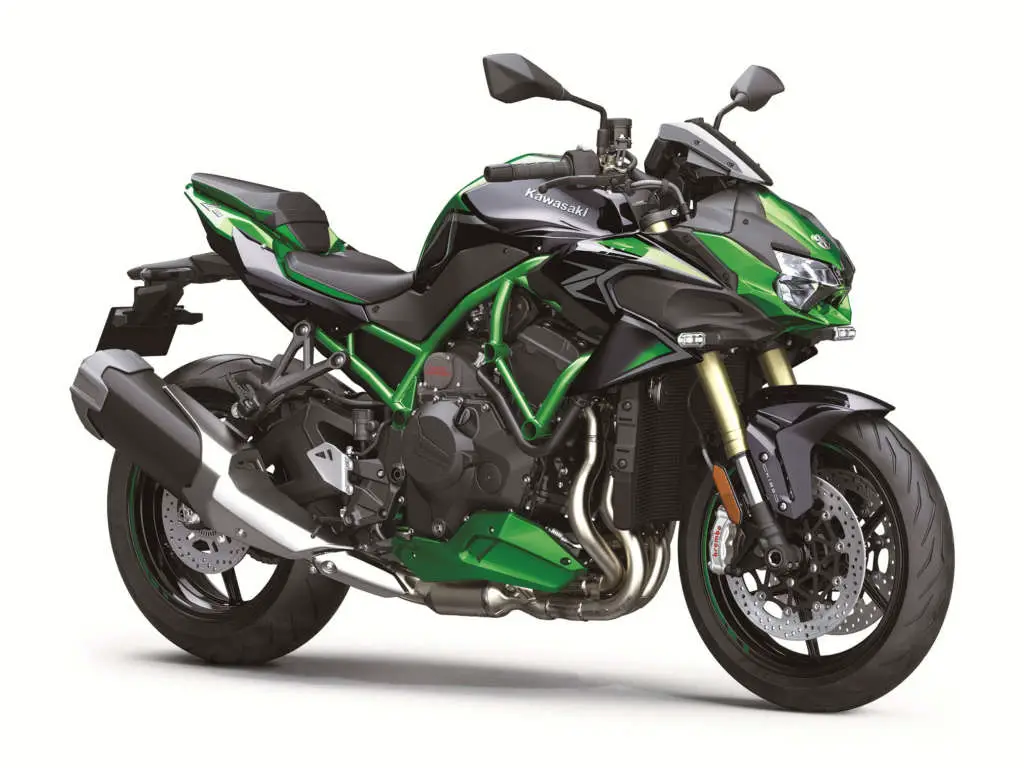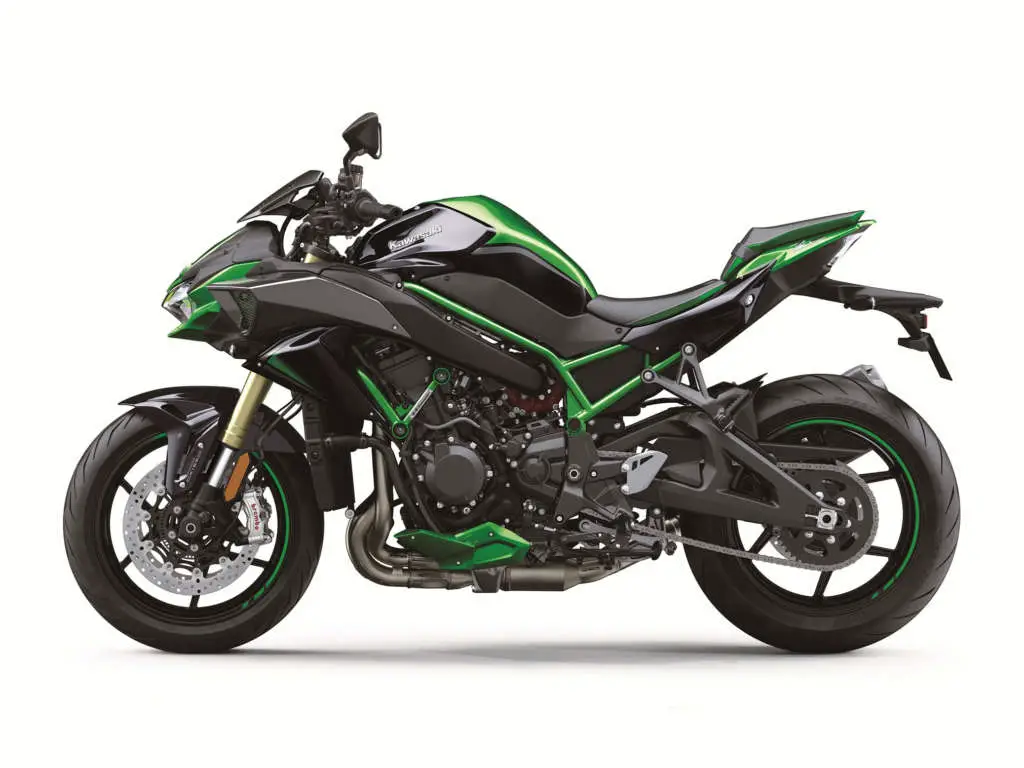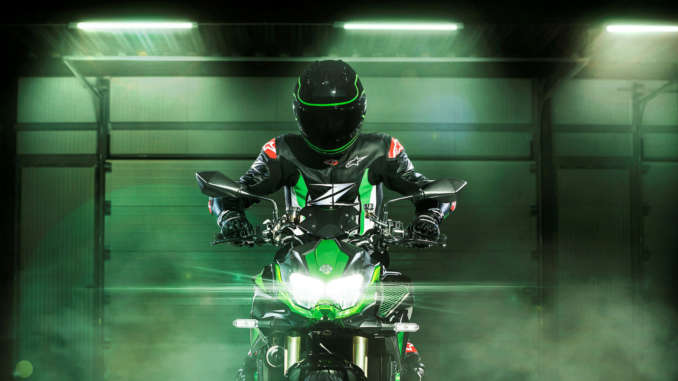
2021 Kawasaki Z H2 SE : SUPERCHARGE YOUR LIFESTYLE.
Introducing the new 2021 Kawasaki Z H2 SE…
Based on the incredible Z H2, the new Z H2 SE retains the ultimate combination of outright power and performance from the standard model but adds KECS (Kawasaki Electronic Control Suspension) with Showa’s Skyhook technology that makes adjustments for road conditions in real time to deliver both suppleness (ride comfort) and firmness (sport riding) for a smoother ride, plus Brembo Stylema front brake components that add to even greater stopping power.
Kawasaki’s flagship model of the Z line of naked motorcycles just got better as the 2021 Z H2 SE adds a smoother ride and more stopping power to the already innovative Z H2 package.
While retaining the ultimate combination of outright power and controllability, the new 2021 Kawasaki Z H2 SE comes equipped with Kawasaki Electronic Control Suspension (KECS). The new electronic suspension also features Showa’s Skyhook technology, delivering a smoother ride, which contributes to increased comfort and enjoyment. Complementing the high-tech suspension are premium Brembo® front brake components, which add to even greater stopping power and control.
The Z H2 SE was developed to deliver supercharged power, a chassis that provides superb maneuverability, daily comfort, and a host of advanced features designed for maximum functionality. The Kawasaki Z H2 SE is a truly unique motorcycle and offers a glimpse of the future.
Kawasaki’s legacy of creating motorcycles that have unrivaled performance, excitement, and Sugomi™ styling continues with a flagship model of the Kawasaki Z line of naked motorcycles, the Z H2 supercharged hypernaked. The next-level Z H2 SE hypernaked combines the balanced supercharged engine with premium components including Kawasaki Electronic Control Suspension (KECS) with Showa Skyhook EERA Technology and Brembo® Stylema calipers.
2021 Kawasaki Z H2 SE Totalmotorcycle.com Key Features
- NEW Kawasaki Electronic Control Suspension with Skyhook EERA Technology
- NEW Brembo® Stylema Monobloc Brake Calipers and Brembo Front Brake Master Cylinder
- Powerful 998cc Balanced Supercharged Engine
- Dog-Ring Transmission
- Specially Designed, Lightweight Trellis Frame
- High-Performance Showa Suspension Components
- Aggressive Sugomi™ Styling and Minimalist Bodywork
- LED Lighting
- All-Digital TFT Color Instrumentation
- Smartphone Connectivity via RIDEOLOGY THE APP
- State-of-the-Art Electronics
- Special Color and Graphics
- NEW Kawasaki Electronic Control Suspensions (KECS) with Showa Skyhook EERA Technology
- NEW Brembo® Stylema Front Calipers
- Stainless Steel Braided Brake Lines
- Kawasaki Quick Shifter (KQS)
- Kawasaki Launch Control Mode (KLCM)
- Kawasaki Cornering Management Function (KCMF)
- Electronic Cruise Control
- Integrated Riding Modes
- Assist & Slipper Clutch
- All Digital TFT Color Instrumentation
- Smartphone Connectivity via RIDEOLOGY THE APP
- All LED Lighting
2021 Kawasaki Z H2 SE Totalmotorcycle.com Features and Benefits
Suspension
The 2021 Z H2 SE features KECS, Kawasaki’s semi-active electronic suspension system, which adapts to road and riding conditions in real-time, providing the ideal amount of damping by combining high-level mechanical components with the latest electronic control technology; KECS balances suppleness for daily commuting with firm damping to facilitate more sporty riding.
Showa’s Skyhook EERA (Electronically Equipped Ride Adjustment) technology offers an even more composed ride. Damping is adjusted electronically to suit vehicle speed and suspension stroke speed. Deceleration is also taken into account, allowing the pitching that occurs under braking to be managed. Showa’s Skyhook software was carefully fine-tuned by Kawasaki engineers to ensure the Z H2 SE’s sporty riding character remained, delivering a smoother ride as it continually adapts to the road surface in real-time. The Skyhook concept imagines a hook supporting the motorcycle’s sprung weight and modulates the suspension’s damping force to allow the wheels to track the dips and bumps encountered while maintaining the motorcycle’s vertical position with minimal disturbance. In Rain Mode, the Skyhook software reduces pitching, steering remains light, and the machine feels more planted by also taking into account vertical acceleration and pitch rate (each confirmed every 10 ms) when determining the damping force required.
The mechanical components are controlled via a solenoid valve with direct (single-stage) actuation. This results in a rapid reaction time of one millisecond, which is much quicker than systems that rely on step-motors or those that use pilot valves (two-stage actuation), which slow the system’s responsiveness. The quick reaction time gives the KECS system a more natural feeling and is ideal for sport riding applications, where real-time reaction to bumps and gaps in the road surface enable superior riding comfort.
The built-in stroke sensors on both the fork and rear shock provide real-time stroke speed and position information. The sensor coils provide input to the KECS ECU every millisecond and are complemented by information provided by the IMU (vehicle acceleration/deceleration), the FI ECU (front/rear wheel speed), and the ABS ECU (front brake caliper pressure) every 10 milliseconds. The KECS ECU then directs current to the solenoids to adjust damping as required by the situation.
The Z H2 SE uses a sporty 43 mm Showa SFF-CA (cartridge) fork and a high-spec BFRC lite rear shock and base damping character set according to the integrated Riding Mode (Sport, Road, Rain, Rider (manual)) selected. KECS then adjusts to the road surface environment in real-time to provide the ideal damping, taking into account vehicle speed, stroke speed and deceleration.
KECS is also monitored by Kawasaki’s advanced IMU-enhanced electronics package joining KTRC, KLCM, and KIBS, KECS as inputs for KCMF (Kawasaki Cornering Management Function) which incorporates multiple engine and chassis systems to facilitate smooth cornering.
Brakes & Wheels
Also new on the Z H2 SE is a premium spec Brembo front brake package which includes Stylema monobloc calipers and a Brembo front master cylinder and steel-braided lines, offering stronger braking performance and enhanced control. The Stylema calipers are lighter, with smaller external dimensions and have less volume around the pistons and brake pads, enabling a more direct response. The Stylema calipers also cool rapidly, thanks to increased airflow around the brake pads, pistons and an opening that allows air to exit from the central bridge.
The lightweight 17” wheels are equipped with Pirelli Diablo Rosso III tires, front and rear. The front tire is a 120/70ZR17 M/C 58W; the rear tire is a 190/55ZR17 M/C 75W.
Engine
The Z H2 SE motorcycle’s balanced supercharged engine is the product of Kawasaki Group technology, designed in-house not only by the Motorcycle and Engine Company, but also with collaboration from the Aerospace Systems Company, Energy System and Plant Engineering Company, and Corporate Technology Division. Kawasaki created a supercharged engine with high output, yet manageable power delivery. The water-cooled DOHC 4-valve parallel 4-cylinder 998cc supercharged engine of the Z H2 SE is tuned to showcase high-performance throughout the rpm range. Its broad powerband creates optimal low-mid range torque for light handling and all-out supercharged performance on the top end. Smooth acceleration in the low to mid rpm range was achieved by shortening the second reduction ratio and optimizing the valve timing. In the chamberless exhaust system, an increase in the manifold assembly’s tube length further improves the output in the low to mid-rpm range output. Where torque is more apparent, in the low to mid-rpm range, the supercharged engine emphasizes easy-to-handle throttle response and smooth acceleration, while in the high-rpm range as the speed increases, the power from the supercharged engine is brought to the forefront. The Z H2 SE also features a ram air intake. The air duct provides a clean path for air flowing linearly from the ram air intake to the supercharged engine, contributing to higher performance.
The street specific Z H2 SE supercharger design and tuning were developed by Kawasaki Heavy Industries, Ltd. (KHI), showcasing the in-house knowledge of forced induction engine performance. The supercharger’s high efficiency and minimal heat gain meant an intercooler was unnecessary, allowing savings in both weight and space. The supercharger is located centrally in the best position to distribute the compressed air to all four cylinders evenly.
The supercharger is driven by a planetary gear train, which runs off the crankshaft. The gear train increases the impeller speed up to 9.2x the crank speed (1.15x step gear with an 8x planetary gear).
Transmission
The Z H2 SE uses a dog-ring transmission that has been developed through feedback from the Kawasaki Racing Team and utilizes optimal gear ratios for street performance. Rather than shifting the gears into place, the gears in this configuration stay in place, with the lightweight dog-rings moving to engage the gears. This design allows the shifting effort to be lighter and shorter for quicker acceleration.
Assist & Slipper Clutch
Complementing the transmission is an Assist & Slipper clutch, race-inspired technology that offers both a back-torque limiting function as well as a light feel at the lever.
The Assist function is noticed by the lighter pull at the clutch lever, helping to reduce rider fatigue, especially in stop and go traffic situations.
The Slipper function is noticed when excessive engine braking occurs as a result of quick or accidental downshifts. The slipper cam comes into play, forcing the clutch hub and operating plate apart, which relieves pressure on the clutch plates to reduce back-torque and help prevent the rear tire from hopping and skidding.
Chassis
A specially designed, lightweight trellis frame delivers both light handling and excellent composure. The chassis offers excellent maneuverability while harnessing the massive supercharged power of the Z H2 SE engine. The compact naked model frame has a high-level of balance between flexibility and toughness so that you can ride on a variety of roads.
The high-tensile steel frame utilizes wheelbase and caster angle dimensions that showcase the light, sporty handling unique to the Z H2 SE. By achieving the desired riding position and center of gravity, the frame and suspension of the Z H2 SE performs well across a range of speeds.
A double-supported swingarm style was chosen for the Z H2 SE, similar to those found on Kawasaki supersport models. It offers the high rigidity and lightweight construction necessary for high performance. The swingarm mounting plate is located on the back of the engine, enabling it to play the role of a cross member in the frame, contributing to rigidity and weight reduction.
Ergonomics
A relaxed riding position has been created by a combination of an upright handlebar shape and a seat with an optimized base plate and cushion thickness. This design provides a high degree of freedom for riding posture and low vibration, allowing for a pleasant and comfortable ride. Adding to the Z H2 SE motorcycle’s comfort and strength is a fat-type handlebar and handle switches.
Electronics & Rider Aids
The strength of Kawasaki’s cutting-edge electronics has always been the highly sophisticated programming that uses minimal hardware to give the ECU an accurate real-time picture of what the chassis is doing and what the rider wants, to best support the rider’s inputs with a natural feel. Using the latest evolution of Kawasaki’s advanced modeling software, including input from a compact Bosch IMU (Inertial Measurement Unit), Kawasaki Cornering Management Function (KCMF) monitors engine and chassis parameters throughout the corner to assist riders in holding their intended line through the corner. The Z H2 SE utilizes the input from multiple sensors to optimize ride quality via the Kawasaki Traction Control (KTRC), Kawasaki Launch Control Mode (KLCM) and the Kawasaki Intelligent Anti-Lock Braking System (KIBS).
Electronic Cruise Control
The Z H2 SE is equipped with electronic cruise control, which improves overall comfort for those long days on the road. The cruise control system enables riders to set and maintain their desired speed with the simple press of a button. Once activated, the rider does not have to constantly apply the throttle to maintain speed. The cruise control helps to reduce rider fatigue when traveling on open roads, allowing the rider to relax and enjoy cruising, contributing to a high level of riding comfort.
KQS (Kawasaki Quick Shifter)
The Z H2 SE features a highly reliable contactless-type quick shifter that allows for ultra-quick, full power upshifts and seamless acceleration. The system detects that the shift lever has been actuated and sends a signal to the ECU to cut ignition so that the next gear can be engaged for clutchless shifting.
Power Mode Selection
Riders can set power delivery to suit conditions and/or preference, choosing from Full, Middle and Low. Middle Power is 75% of Full Power, while Low Power is 50% of Full Power.
Styling
The styling of the Z series flagship Z H2 SE has been shaped according to the Sugomi design concept and the minimalist bodywork that Kawasaki’s Z series lineup of motorcycles is known for. Sugomi describes the unique aura that radiates from beings possessing compelling presence and unrivaled power. Featuring a low crouching stance and the asymmetry of the air intake duct installed on the left side of the vehicle body, the Z H2 SE intensely and aggressively emphasizes the identity of Sugomi design. Only the air intake duct and the under cowl are asymmetrical; all other design work represents accurate symmetry, giving the Z H2 SE a well-balanced and highly harmonious design.
The supercharger housing is visible from the outside thanks to the naked model concept that does not have a cowl covering the motorcycle’s body. Providing a glimpse of the supercharger between the frame makes for a more impressive appearance.
The Z H2 SE is equipped with an LED headlight and taillight. The bulbs’ low power consumption and high durability improve maintainability while providing high-light intensity and high illumination with a clean headlight beam spread. The frame-mounted headlamps also influence the styling around the front and create an innovative look that is different from previous naked models.
TFT Color Instrumentation
The 4.3” all-digital TFT color instrumentation gives the cockpit of the Z H2 SE motorcycle a high-tech, high-grade appearance. The full-color display features TFT (thin-film transistor) technology and delivers a high level of visibility. Display functions include: digital speedometer, gear position indicator, shift indicator, odometer, dual trip meter, fuel gauge, remaining range, current/average fuel consumption, outside temperature, coolant temperature, clock, Economical Riding Indicator, IMU indicator, KIBS indicator, boost pressure and boost temperature.
RIDEOLOGY THE APP
Kawasaki continues to offer its Z lineup the addition of Bluetooth® Smartphone Connectivity. A chip built into the instrument panel enables riders to connect to their motorcycle wirelessly. Using RIDEOLOGY THE APP*, several instrument functions can be accessed, logged, and reviewed, contributing to an enhanced motorcycling experience. The following information can be viewed:
- Vehicle Info
- Check latest status update
- Riding Log
- Can be logged in detail and played back for review
- Route, Distance & Time travelled can be logged for review
- Riding conditions can be recorded in detail
- Telephone Notifications
- Provides a notification on the dash when a call or mail is received by smartphone
- Tuning
- General instrument display setting changes can be made on your smartphone
- Kawasaki Riding Management modes can be set
The app can also be used when away from the motorcycle. When riding (with the app ON), the bike and smartphone are always connected and riding log data is being recorded by the app. After the ride is complete, the latest riding information is stored by the app and may be viewed on the smartphone. Any changes made via the app while the engine is off, or while out of range, will be implemented as soon as the ignition is turned on and the smartphone is in range with the app ON.
* RIDEOLOGY THE APP is not intended for use during vehicle operation. Only use RIDEOLOGY THE APP when the vehicle is not being operated and it is safe to do so.
Colors
The 2021 Kawasaki Z H2 SE motorcycle is available in Golden Blazed Green/ Metallic Diablo Black.
INDEPTH FEATURES
BALANCED SUPERCHARGED ENGINE
Based on the supercharged engine of the Ninja H2™ motorcycle, the Balanced Supercharged Engine achieves a balance of power for exhilarating acceleration while providing better fuel efficiency and more street-oriented performance.
Supercharged Intake
- Kawasaki designed and built centrifugal type supercharger has a high pumping capacity.
- Planetary gear gets driving force from the crankshaft and spins a 69mm impeller that was specially designed using Kawasaki Gas Turbine and Aerospace technology.
- Since the supercharger design is highly efficient, compressed intake air is minimally heated so no intercooler is necessary.
- Ram air intake duct feeds the supercharger fresh air in as straight a line as possible to help provide high output.
- Aluminum intake chamber between supercharger and throttle bodies helps radiate heat to keep intake air cool.
- The frontal area of the left-side intake is designed to match the airflow requirements of the Balanced Supercharged Engine. The intake duct feeds the supercharger fresh air in as straight a line as possible to contribute to the supercharger’s efficiency.
- The 69mm supercharger impeller was designed to optimize blade shape and angle for the Balanced Supercharger Engine broad power characteristics. Settings for rpm and airflow volume for maximum efficiency were also optimized.
- Formed from a forged aluminum block using a five-axis CNC machining center to ensure high precision and durability, the impeller has six blades at the tip expanding to 12 blades at the base. Grooves etched into the blade surfaces help direct airflow.
- Planetary gear train, specially designed using Kawasaki Gas Turbine and Aerospace technology, is driven by the crankshaft and increases the impeller speed to 9.2 times that of the crankshaft.
- Aluminum intake chamber between supercharger and throttle bodies has optimized volume, die-cast construction and diffuser at the mouth of the chamber that contribute to overall supercharger efficiency, engine performance and fuel efficiency. A stainless steel net at the end of the diffuser helps smooth airflow.
- Optimized and irregular intake funnel lengths help boost low- and mid-range performance. The funnels for the outer cylinders are shorter than those in the middle.
- ECU-controlled blow-off valve regulates pressure gain in intake chamber when throttle is closed to prevent impeller surging and help prevent vibration. Quick valve operation response maintains optimum boost pressure to contribute to power feeling and throttle response.
- A sound hole in the intake duct allows the rider to enjoy the supercharger’s characteristic chirping.
Engine
- Using race technology developed for the multi-time World Superbike Championship winning Ninja® ZX™-10R, a two-stage machining process for the cylinder head forms the throat of the intake ports. The valve seat area is bored twice: once along the same path as the throat; then again for the valve seats. The result is smoother intake airflow, which helps reduce intake loss and increases performance.
- Cam profiles match the airflow requirements of everyday street riding, contributing to the low-mid range focused performance as well as fuel efficiency.
- Intake and exhaust ports match the airflow to boost low-mid range performance and fuel efficiency.
- One-piece cylinder/upper crankcase utilizes dummy cylinder head during honing process for more precise cylinder dimensions, which allows use of low-tension piston rings to reduce mechanical loss and boost engine response.
- High compression ratio increases thermal efficiency and greatly contributes to fuel efficiency.
- Efficient combustion produces less heat so that the pistons can be cooled by a single oil jet, allowing the oil pump to turn at a slower rate to minimize friction loss. This also allows the engine’s oil volume to be optimized which contributes to weight savings.
- Large, deep-sump oil pan helps cool oil. Oil pan design ensures the oil pump is always surrounded by oil to prevent cavitation. Additionally, the unique angled shape and position of the oil strainer also helps prevent cavitation during strong acceleration and deceleration.
- Dual secondary balancers virtually eliminate engine vibration.
Engine Sound Tuning
- Acoustic analysis used to shape the intake duct, tune the operating sound of the supercharger and the intake sound to produce an engine sound that is unique to the Z H2.
Exhaust System
- Chamberless exhaust system with long header pipes helps boost low and mid-range power.
- Minimal muffler size helps reduce weight.
Kawaskai DFI®(KP) with Electronic Throttle Valves (ETV)(KP)
- 40mm Electronic Throttle Valves enable the ECU to control the volume of both the fuel (via fuel injectors) and the air (via throttle valves) delivered to the engine. Ideal fuel injection and throttle valve position results in smooth, natural engine response and the ideal engine output. The system also enhances input to the traction control system and accommodates the Kawasaki Launch Control and Kawasaki Engine Brake Control features.
- ETV allows cruise control system to be implemented so that a desired speed can be maintained with a push of a button for added touring comfort.
- The throttle pulley operates an Acceleration Position Sensor (APS) that uses the ECU to send a signal to a small motor that operates the throttle valves. This makes throttle pull very light for reduced rider fatigue.
Cruise Control
- Electronic cruise control has single-button activation to maintain selected speed, which can also be adjusted with adjacent up/down toggle.
Transmission
- Dog-ring transmission uses MotoGP technology in which the gears are fixed to the input transmission shafts and rings move to engage the gears on the output shaft. The result is lighter shifting, improved feel and quicker shifts.
- Transmission oil jets aimed at every gear mesh and shift fork position provide direct cooling and exceptional lubrication for high durability.
- Primary gear ratio designed to contribute to fuel efficiency, while helping to reduce the torque load on the transmission gears. First and second gear ratios also contribute to engine manageability in most everyday riding situations.
Kawasaki Quick Shifter (KQS)
- Contact-less potentiometer-type quick shifter for quick upshifts that enable seamless acceleration without backing off the throttle.
- During deceleration when the throttle is completely closed and engine speed is not near redline, KQS automatically controls engine speed to allow downshifting without operating the clutch lever.
Assist & Slipper Clutch
- Using the rotational forces of the clutch hub and pressure plate, the clutch is forced together during acceleration (Assist function) so that fewer and lighter clutch springs can be used for a lighter feel at the lever. During high back-torque, such as when too low of a gear is selected during downshifting, the Slipper function allows some clutch slippage to help prevent engine lock-up, stalling and rear wheel hop.
ELECTRONIC CONTROLS
KAWASAKI NEXT LEVEL ELECTRONICS
- Kawasaki’s cutting-edge electronics have always excelled on the track due to the highly sophisticated programming that gives the ECU an accurate, real-time picture of what the chassis is doing using minimal software. With a Bosch IMU and the latest evolution of Kawasaki’s proprietary dynamic modeling software, the Z H2 motorcyle’s electronic management technology is next level, changing from setting-type and reaction-type systems to feedback-type systems.
Inertial Measurement Unit (IMU)(KP)
- The IMU measures inertia along 5 axes: acceleration along longitudinal, transverse and vertical axes, roll rate, and pitch rate. The yaw rate is calculated by the ECU using Kawasaki’s patented software to provide six-axis chassis attitude input of lean angle and acceleration/deceleration force for more precise management of the electronic riding aids.
- The IMU allows KTRC to incorporate more feedback to help maximize acceleration when exiting corners on the track.
- Unlike competitors’ systems that have pre-set limits, Kawasaki’s proprietary race-developed software enables the Z H2 to have a dynamic system that has a higher level of chassis awareness and adapts to changing conditions such as rider inputs, vehicle attitude, and pavement conditions.
Kawasaki Cornering Management Function
- Corner Management Function uses both KIBS and KTRC to assist riders in tracing their intended line through a corner by suppressing the tendency for the bike to stand up while braking in a turn. The IMU helps the system maintain optimum hydraulic pressure based on the bike’s lean and pitch angles.
Kawasaki Launch Control Mode (KLCM)
- Designed to assist the rider by optimizing acceleration from a stop, KLCM electronically controls engine output to help prevent wheelspin and thereby minimize front end lift when launching from a standstill.
Kawasaki Traction Control (KTRC)
- Mode 1 prioritizes forward acceleration, while Mode 2 offers a balance between acceleration performance and rider reassurance. Mode 3 provides rider reassurance by facilitating smooth riding on slippery surfaces.
- The system confirms conditions every 5 milliseconds and uses ignition cut and airflow control (via the electronic throttle valves), enabling extremely quick reaction.
- Using complex analysis, the system monitors traction conditions. By acting before slippage exceeds the range for optimum traction, drops in power can be minimized, resulting in ultra-smooth operation.
Power Modes
There are three modes to allow riders to select power delivery to suit preference and conditions.
Full: Full power operation
Middle: Limited operation, about 75% of full
Low: Limited operation, about 50% of full
Integrated Riding Modes:
Sport, Road, Rain, Rider (manual)
- All-inclusive modes that link KTRC, Power Mode and KECS allow riders to efficiently set traction control, power delivery and suspension character to suit a given riding situation.
- Riders can choose from Sport, Road, Rain or a manual setting (Rider). In the manual Rider mode, each of the systems can be set independently.
– Sport: enables riders to enjoy sporty riding on winding roads.
– Road: offers comfortable riding over a wide range of situations, from city riding to highway cruising and rural roads.
– Rain: offers rider reassurance when riding on a wet road surface.
| RIDING MODE | KTRC | POWER MODE | KECS |
| Sport | 1 | F | Hard |
| Road | 2 | F | Normal |
| Rain | 3 | L | Soft |
| Rider (manual) | 1,2,3 or Off | F or L | Hard, Normal or Soft(Compression/Rebound: +5/-5) |
2021 Kawasaki Z H2 SE – Totalmotorcycle.com USA Specifications/Technical Details
US MSRP Price: $ 19799 USD
Canada MSRP Price: $ 23099 CDN
Europe/UK MSRP Price: from £ 18349 GBP (On The Road inc 20% Vat)
Engine Type 4-Stroke, 4-Cylinder, Liquid-Cooled, DOHC, 4 Valve Cylinder Head, Supercharged
Displacement 998 cc
Bore & Stroke 76.0 x 55.0 mm
Maximum Torque 101 lb.-ft @ 9,500 rpm
Compression Ratio 11.2:1
Fuel System DFI® with 40mm Throttle Bodies (4) and Dual Injectors
Ignition TCBI with Digital Advance
Transmission 6-Speed, Dog-Ring
Final Drive Sealed Chain
Rake/Trail 24.9° / 4.1 in.
Front Wheel Travel 4.7 in.
Rear Wheel Travel 5.3 in.
Front Tire Size 120/70-17
Rear Tire Size 190/55-17
Wheelbase 57.3 in.
Front Suspension 43mm Inverted Fork with KECS-controlled compression
and Rebound Damping and Manually-Adjustable Preload
Rear Suspension Horizontal Back-link, KECS-controlled compression
and Rebound Damping and Electronically-Controlled Preload Adjustment
Front Brake Type Dual Semi-Floating 320mm Discs with
Radial-Mount, Opposed Brembo Stylema 4-Piston Calipers
Rear Brake Type 260mm Disc with Opposed 2 Pistion Caliper
Fuel Tank Capacity 5.0 gal.
Seat Height 32.7 in.
Curb Weight= 529.2 lb.
Warranty 12 months
Kawasaki Protection Plus™ 12, 24, 36 or 48 months
2021 Kawasaki Z H2 SE – Totalmotorcycle.com Canadian Specifications/Technical Details
Engine 998cc, liquid-cooled, 4-stroke DOHC 16-valve in-line four
Bore x Stroke 76.0 x 55.0 mm
Compression Ratio 11.2:1
Fuel System Fuel injection: ø40 mm x 4
Intake System Kawasaki Supercharger
Ignition Digital
Starting Electric
Lubrication Forced lubrication, wet sump with oil cooler
Transmission 6-speed, return, dog-ring
Clutch Wet multi-disc, manual
Final Drive Chain
Frame Trellis, high-tensile steel, with Swingarm Mounting Plate
Front Suspension / Wheel Travel ø43 mm inverted fork (SFF-CA) with KECS-controlled compression and rebound damping, manual spring preload adjustability, and top-out springs / 120 mm (4.7 in)
Rear Suspension / Wheel Travel New Uni Trak, BFRC lite gas-charged shock with piggyback reservoir, KECS-controlled compression and rebound damping, manual spring preload adjustability, and top-out spring / 134 mm (5.3 in)
Rake / Trail 24.9° / 104 mm
Steering Angle (L/R) 29° / 29°
Front Tire 120/70ZR17M/C (58W)
Rear Tire 190/55ZR17M/C (75W)
Front Brakes Dual semi-floating ø320 mm discs with radial-mount, Brembo Stylema monobloc, opposed 4-piston calipers
Rear Brake ø260 mm disc with single-piston caliper
Dimensions (L x W x H) 2,085 x 815 x 1,130 mm (82.1 x 32.1 x 44.5 in)
Wheelbase 1,455 mm (57.3 in)
Road Clearance 140 mm (5.5 in)
Seat Height 830 mm (32.7 in)
Curb Mass** 240 kg (529 lb)
Fuel Capacity 19 litres
Instrumentation Full-colour TFT screen with digital speedometer, gear position indicator, shift indicator, odometer, dual trip meters, fuel gauge, remaining range, current/average fuel consumption, outside temperature, coolant temperature, clock, Economical Riding Indicator, IMU indicator, KIBS indicator, boost pressure and boost temperature.
Warranty 12 months
Kawasaki Protection Plus 12 / 24 / 36 / 48 months
2021 Kawasaki Z H2 SE – Totalmotorcycle.com European Specifications/Technical Details
Engine
Engine type Liquid-cooled, 4-stroke In-Line Four with Supercharger
Displacement 998 cm³
Bore x stroke 76 x 55 mm
Valve system DOHC, 16 valves
Fuel system Fuel injection: Ø40 mm x 4
Starting System Electric
Gear Performance & Transmission
Maximum power 147.1 kW {200 PS} / 11,000 rpm
CO2 emission 139 g/km
Maximum torque 137 N•m {14 kgf•m} / 8,500 rpm
Transmission 6-speed
Gear Ratios 1st 3.077 (40/13)
Gear Ratios 2nd 2.471 (42/17)
Gear Ratios 3rd 2.045 (45/22)
Gear Ratios 4th 1.727 (38/22)
Gear Ratios 5th 1.524 (32/21)
Gear Ratios 6th 1.348 (31/23)
Final reduction ratio 2.556 (46/18)
Clutch Wet multi-disc, manual
Suspensions Brakes & Suspension
Brakes, front Dual semi – floating 320mm discs, Caliper: Dual radial – mount, Brembo M4.32 monobloc, opposed 4-piston
Brakes, rear Single 260mm disc. Caliper: 2 – piston
Suspension, front Showa SFF-BP Fork with Adjustable Compression and Rebound Damping, Spring Preload Adjustability
Suspension, rear New Uni-Trak, Showa Gas-Charged Shock with Adjustable Compression and Rebound Damping, Preload Adjustability
Dimensions Frame & Dimensions
Frame type Trellis, high-tensile steel
Wheel travel front 120 mm
Wheel travel rear 134 mm
Tyre, front 120/70ZR17M/C (58W)
Tyre, rear 190/55ZR17M/C (75W)
Wheelbase 1,455 mm
Fuel capacity 19 litres
Seat height 830 mm
Curb mass 239 kg
Manufacturer Specifications and appearance are subject to change without prior notice on Total Motorcycle (TMW).


